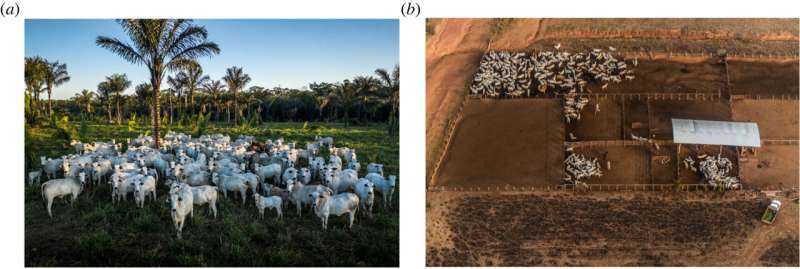Contrasting beef systems in Brazil. (a) low-yielding pasture adjacent to rainforest and (b) a high-yielding feedlot system. To understand the relative EID risks of each system, it is important to consider the risks associated with both livestock management and land use. Photos reprinted with permission from Fábio Nascimento. Credit: Royal Society Open Science (2022). DOI: 10.1098/rsos.211573
A team of researchers from the University of Cambridge and the University of Leeds has found evidence that we currently lack adequate information to reach a robust view of the relationship between contrasting livestock systems and emerging infectious disease (EID) risk. In their paper published in the journal Royal Society Open Science, the group describes their review of livestock production methods and the likelihood of EIDs.
Over the past few decades, as epidemics and a major pandemic have threatened the health and lives of millions of people, some have pointed the finger at livestock production as a potential source of pandemics of zoonotic origin, and several studies have backed up such fears. As part of the debate, researchers have suggested that some modern livestock farming practices may be leading to a bigger risk of diseases transmitted from animals to humans. More specifically, some have suggested that intensive livestock farming increases the risk of a pandemic because of the high animal populations, overall poor heath, lowered disease resistance and a lowering of genetic diversity.
But missing from the debate, say the researchers of this new study, is actual evidence that high-intensity livestock farming poses more of a risk. To test the idea, the researchers reviewed the evidence of links between livestock production and the development of EIDs for each of the possible factors involved in both high- and low-intensity livestock farming.
They found that one factor often overlooked in such research was land use. High-intensity livestock farming, they noted, uses far less acreage per pound of food produced than does low-intensity farming. And higher amounts of land use mean creating ever bigger farms that encroach on land in its natural state. Encroachment, they note, has been shown to have the highest potential of development of EIDs.
Thus, they suggest, that while overall intensive livestock production may produce more EIDs, it is only because it involves so many more animals. If all of the farms currently using intensive techniques converted to less intensive techniques, it would mean converting millions of acres to livestock production, which could lead to a very large increase in the numbers of EIDs.
More information: Harriet Bartlett et al, Understanding the relative risks of zoonosis emergence under contrasting approaches to meeting livestock product demand, Royal Society Open Science (2022). DOI: 10.1098/rsos.211573
Journal information: Royal Society Open Science
© 2022 Science X Network
























